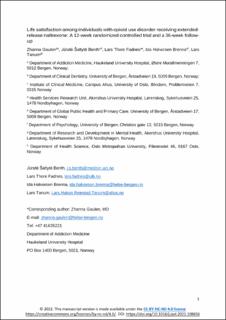| dc.contributor.author | Gaulen, Zhanna | |
| dc.contributor.author | Saltyte Benth, Jurate | |
| dc.contributor.author | Fadnes, Lars T. | |
| dc.contributor.author | Brenna, Ida Halvorsen | |
| dc.contributor.author | Tanum, Lars Håkon Reiestad | |
| dc.date.accessioned | 2023-01-03T09:53:09Z | |
| dc.date.available | 2023-01-03T09:53:09Z | |
| dc.date.created | 2021-11-26T20:15:10Z | |
| dc.date.issued | 2021-02-15 | |
| dc.identifier.citation | Journal of Substance Abuse Treatment. 2021, . | en_US |
| dc.identifier.issn | 0740-5472 | |
| dc.identifier.issn | 1873-6483 | |
| dc.identifier.uri | https://hdl.handle.net/11250/3040533 | |
| dc.description.abstract | Introduction: Life satisfaction (LS) in opioid-dependent individuals is lower than in the general population. This study aimed to explore changes in LS during short- and long-term treatment with extended-release naltrexone (XR-NTX).
Methods: This open-label 12-week clinical trial randomized 159 participants to either monthly XR-NTX or daily buprenorphine-naloxone (BP-NLX). In a subsequent 36-week follow-up study on XR-NTX, participants either continued or switched to XR-NTX. The study collected data on the Temporary Satisfaction with Life (TSWL) and illicit opioid use every fourth week. The research team assessed changes in TSWL by a linear mixed model and growth mixture model. The study assessed relationship between opioid use and TSWL by a linear mixed model.
Results: Change in LS differed significantly between the groups in both study periods. TSWL scores were significantly higher in the XR-NTX group at week 4 (p = 0.013) and week 8 (p = 0.002). In the follow-up period, the groups were significantly different only at week 16 (p = 0.031) and week 48 (p = 0.025), with the higher TSWL scores in the XR-NTX continued group. Increase in opioid use by one day was associated with a 0.12 point lower mean TSWL score. Both study periods identified groups with low and high LS levels. In the trial period, the TSWL scores exhibited a significant increase from baseline to week 12 in both groups, p < .001 and p = 0.011 in the low and high LS group, respectively. In the follow-up period, the TSWL scores exhibited a significant increase from week 16 to week 48 (p = 0.003) in the high LS group, while the low LS group showed persistently lower values throughout that period.
Conclusions: XR-NTX treatment given once monthly is associated with higher LS, as measured by TSWL, compared to daily use of BP-NLX. The majority of the participants had relatively low TSWL scores and did not report any change in TSWL during longer-term treatment. The study found a significant association between more frequent illicit opioid use and a low or decreased LS during follow-up. | en_US |
| dc.language.iso | eng | en_US |
| dc.publisher | Elsevier | en_US |
| dc.relation.ispartofseries | Journal of Substance Abuse Treatment;Volume 135, April 2022, 108656 | |
| dc.rights | Attribution-NonCommercial-NoDerivatives 4.0 Internasjonal | * |
| dc.rights.uri | http://creativecommons.org/licenses/by-nc-nd/4.0/deed.no | * |
| dc.subject | Life satisfaction | en_US |
| dc.subject | Extended-release naltrexone | en_US |
| dc.subject | Buprenorphine-naloxone | en_US |
| dc.subject | Opioid use disorder | en_US |
| dc.title | Life satisfaction among individuals with opioid use disorder receiving extended-release naltrexone: A 12-week randomized controlled trial and a 36-week follow-up | en_US |
| dc.type | Peer reviewed | en_US |
| dc.type | Journal article | en_US |
| dc.description.version | acceptedVersion | en_US |
| dc.source.articlenumber | 108656 | en_US |
| cristin.ispublished | true | |
| cristin.fulltext | preprint | |
| cristin.qualitycode | 1 | |
| dc.identifier.doi | https://doi.org/10.1016/j.jsat.2021.108656 | |
| dc.identifier.cristin | 1960056 | |
| dc.source.journal | Journal of Substance Abuse Treatment | en_US |
| dc.source.volume | 135 | en_US |
| dc.source.issue | 135 | en_US |
| dc.source.pagenumber | 20 | en_US |
| dc.relation.project | Norges forskningsråd: 204725 | en_US |

